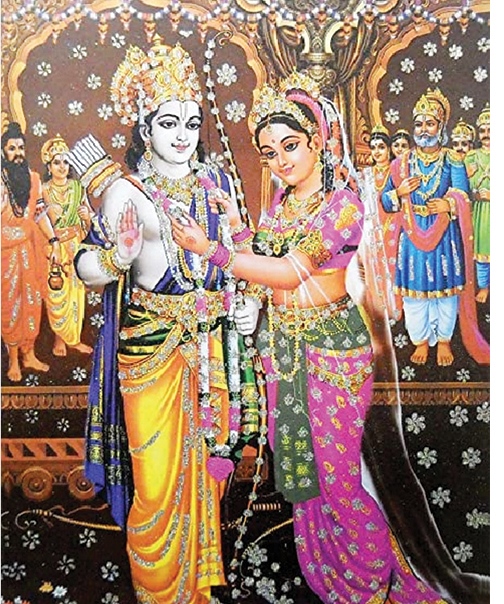
Dr. Ram Sagar Pandit
Every year we celebrate the wedding anniversary day of Ram and Sita in Janakprudham. On this day, we remember the marital relation between Mithila and Ayodhya. In ancient time, both the countries were famous because of learned sage king Janak and great king Dasharath.
King Janak was the sage of sages (a great sage) and king Dasharath the king of kings (emperor). Janakpurdham was the capital city of ancient Mithila, which was bounded by the Koshi River in the east, the Narayani River in the west, Himalaya in the north and Ganga in the south. It was the miraculous and marvellous land from at the period of the Ramayan. Now, Janakpurdham is a town of temples, hermitages, and ponds. It is also the capital city of Province 2.
King Janak was committed to marrying off his daughter Sita to a man capable of breaking the pinank bow. Among kings, nobody could break the bow. Lastly, Ram, the prince of Ayodhya, broke the bow and married Sita.
In memory of that event, the bow breaking ceremony is performed on the auspicious occasion of Vivah Panchami (on the fifth day of bright half of the month December/Mansir) every year. An area has been prepared for the bow breaking contest at Ranghbhoomi Maidan.
A grand procession starts from Ram temple. It passes through Janaki temple before meeting at the bow breaking area. Idols of Ram and Sita are taken on two separate palanquins carried by four saints in this procession. In the garland ceremony, Ram and Sita exchange their beautiful garlands with each other in the presence of thousands of people, with the devotees chanting the slogans of Ram and Sita.
All practical rituals of Maithil marriage system are performed by chanting mantras. Different marriage folk dances with songs are performed for the entertainment of audiances. During this time, different musical bands are played. And the wedding programme is performed in the Janaki temple and Ram-Sita Vivah Mandap.
After this, ceremony of garlanding programme begins. The head priest of Ram temple plays the role of Ram’s father Dasharath and that of Janaki temple plays the role of Janaki’s father Janak.
Great many people from different areas of Nepal and India come to observe this. In recent years, a number of foreigners coming to observe the festival is also increasing.
During the festival, businesses of Janakpurdham swell. After the end of garlanding programme, a grand marriage ceremony is held in which Ram and his three brothers — Lakshman, Bharat and Shatrughna — are married to Sita, Urmila, Mandavi and Shrutikriti respectively. They all circumambulate the sacrificial fire in accordance with the marriage ritual prevalent in Mithila. They are blessed by sage king Janak, queen Sunaina, king Dashrath, along with their Guru.
The wedding ceremony of Ram and Sita is solemnised in the Vivah Mandap every year on the auspicious occasion of Vivah Panchami.
On this occasion, Ram and Sita appear in their wedding attire. The Mandap lies north to the Janaki temple in the same compound. Different idols of gods, goddesses, saints and sages are installed here.
They represent Janakpur and Ayodhya. This is a very attractive canopy where Dasharath and Janak are seen seated at the centre with their family priests. This building represents the Nepali architectural style.
A grand fair takes place on the auspicious occasion of the festival in Janakpurdham. Inaddition to countless people from Nepal and India, hundreds of hermits and sages come to attend the great fair. On the occasion, the whole Janakpurdham is decorated with multi-coloured electric bulbs with especial decoration of Janaki temple.
Another charming religious programme is put on display by the artists of Ramalila during the night time starting from Panchami (the fifth day of a lunar fortnight) to Purnima (full- moon day).
A good arragement is made by the Ram Madir, Janaki Mandir, Guthi Sansthan, Janakpur Sub Metropolitan City and Provicinial Government for those saints and sages who are registered with the monasteries, temples, heritages and shrines.
They get free food and lodging during the fair. What’s more, Janakpurdham and its surrounding areas become the meeting places of relatives and guests. All local people and the guests enjoy the festive time together as they buy different things in the market.
The next day of wedding programme, farewell ceremony, is performed by Ram Mandir. Many precious things are offered by Janaki temple as a dowry. The idols of Ram and Sita are dressed as a bridegroom and bride. They are carried on a chariot and followed by a muscial band party at the time of marriage ceremony. This procession of people is called ‘Barati’ in local language.
Until a few decades ago, elephants, horses, bullockcarts were in use for the procession, but now they are replaced by vehicles. At the time of procession, flowers are thrown from helicopter. Every year, this festival reminds us of the great event of Ramayana period.
We remember Ram and Sita as the incarnation of god and goddess whom we still worship with reverence. Accoding to the Devi Upanishad Puran, Sita’s whole life passed as an ideal woman. She is the example of the ideal women from ancient to present. Maithil and other women still have unwavering faith in chasity and follow Sita’s footsteps in every walk of life.
In the fair, however, some weaknesses are also seen: toilet facilities are not sufficient because of the poor management of sanitation, pickpocketings and beggings are rife. In order to keep such problems at bay, concerned administration, in collaboration with the local people, should play a critical role.
(TRN)






